Literature Review: Public Health Strategies for Skin Cancer Prevention
VerifiedAdded on 2023/02/01
|18
|4496
|23
Report
AI Summary
This literature review assesses the effectiveness of public health strategies for skin cancer prevention in Australia. It systematically reviews peer-reviewed articles from 2014 to 2019, primarily sourced from the USC library, Sage Publications, and Wiley Online. The review employs a critical literature review methodology, following a six-step systematic procedure. The study investigates the impact of various strategies, including public information campaigns, cancer prevention programs, and professional education initiatives. The findings reveal that while many studies address skin cancer prevention, limitations in response rates and data restrict definitive conclusions. The review highlights key barriers such as inadequate understanding and mistrust of health service providers, while identifying sunlight exposure, family history, and melanoma as significant risk factors. The results suggest a need for collaborative programs between government and health professionals to enhance awareness, health education, and routine skin care. The review concludes with recommendations for future research and public health interventions to address the gaps in current strategies and improve skin cancer prevention efforts in Australia. The review also includes a sanity table and search strings in the appendix.
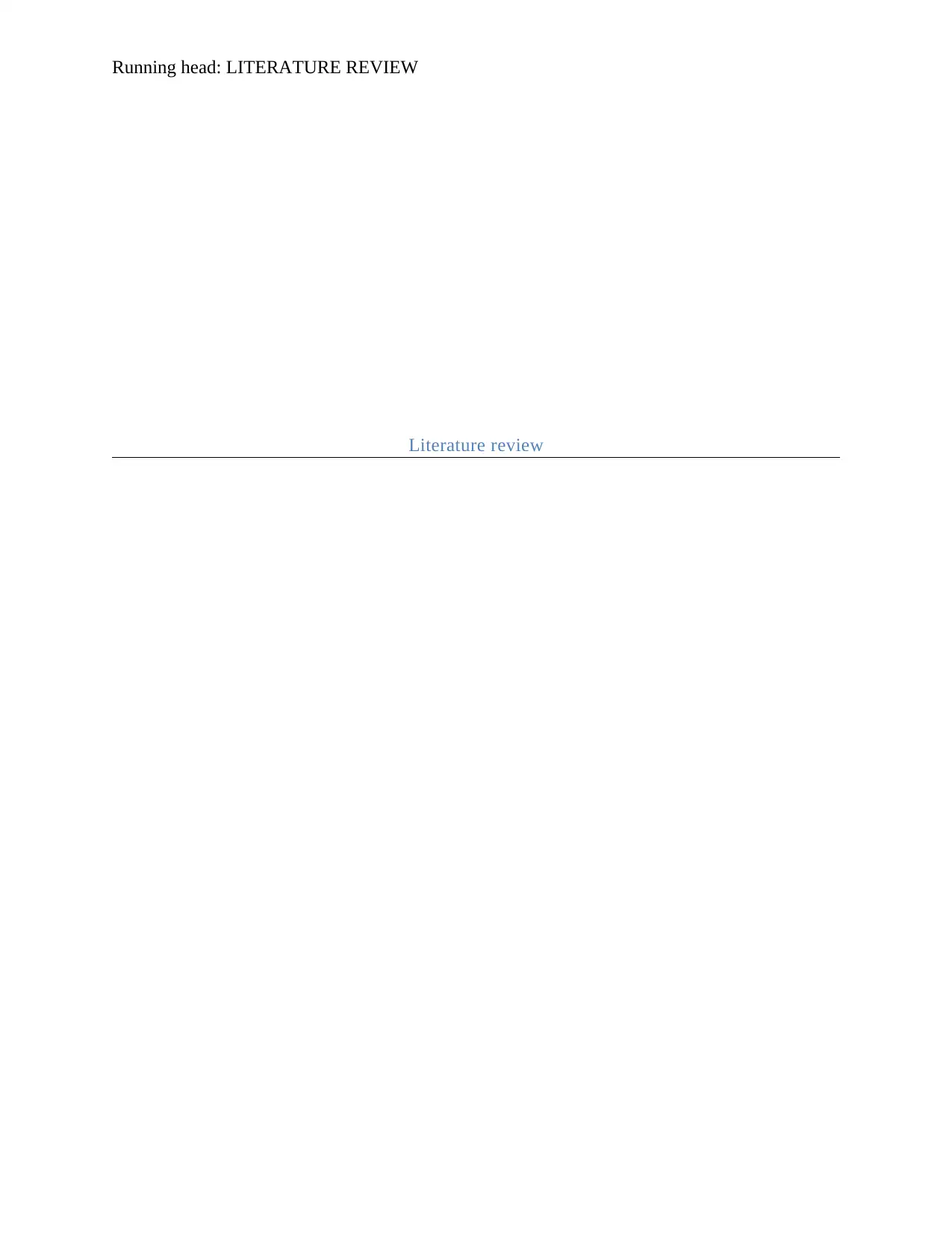
Running head: LITERATURE REVIEW
Literature review
Literature review
Paraphrase This Document
Need a fresh take? Get an instant paraphrase of this document with our AI Paraphraser
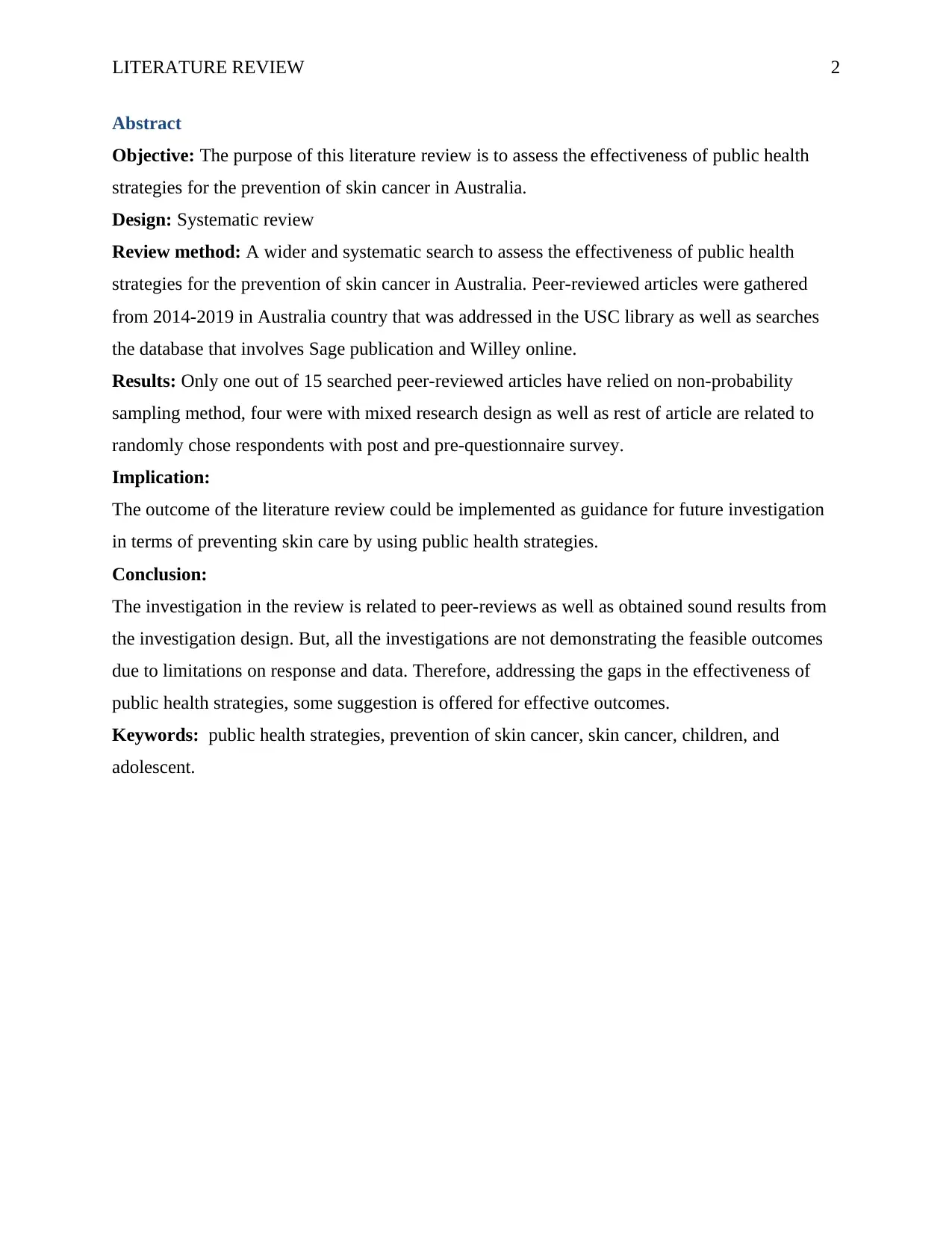
LITERATURE REVIEW 2
Abstract
Objective: The purpose of this literature review is to assess the effectiveness of public health
strategies for the prevention of skin cancer in Australia.
Design: Systematic review
Review method: A wider and systematic search to assess the effectiveness of public health
strategies for the prevention of skin cancer in Australia. Peer-reviewed articles were gathered
from 2014-2019 in Australia country that was addressed in the USC library as well as searches
the database that involves Sage publication and Willey online.
Results: Only one out of 15 searched peer-reviewed articles have relied on non-probability
sampling method, four were with mixed research design as well as rest of article are related to
randomly chose respondents with post and pre-questionnaire survey.
Implication:
The outcome of the literature review could be implemented as guidance for future investigation
in terms of preventing skin care by using public health strategies.
Conclusion:
The investigation in the review is related to peer-reviews as well as obtained sound results from
the investigation design. But, all the investigations are not demonstrating the feasible outcomes
due to limitations on response and data. Therefore, addressing the gaps in the effectiveness of
public health strategies, some suggestion is offered for effective outcomes.
Keywords: public health strategies, prevention of skin cancer, skin cancer, children, and
adolescent.
Abstract
Objective: The purpose of this literature review is to assess the effectiveness of public health
strategies for the prevention of skin cancer in Australia.
Design: Systematic review
Review method: A wider and systematic search to assess the effectiveness of public health
strategies for the prevention of skin cancer in Australia. Peer-reviewed articles were gathered
from 2014-2019 in Australia country that was addressed in the USC library as well as searches
the database that involves Sage publication and Willey online.
Results: Only one out of 15 searched peer-reviewed articles have relied on non-probability
sampling method, four were with mixed research design as well as rest of article are related to
randomly chose respondents with post and pre-questionnaire survey.
Implication:
The outcome of the literature review could be implemented as guidance for future investigation
in terms of preventing skin care by using public health strategies.
Conclusion:
The investigation in the review is related to peer-reviews as well as obtained sound results from
the investigation design. But, all the investigations are not demonstrating the feasible outcomes
due to limitations on response and data. Therefore, addressing the gaps in the effectiveness of
public health strategies, some suggestion is offered for effective outcomes.
Keywords: public health strategies, prevention of skin cancer, skin cancer, children, and
adolescent.
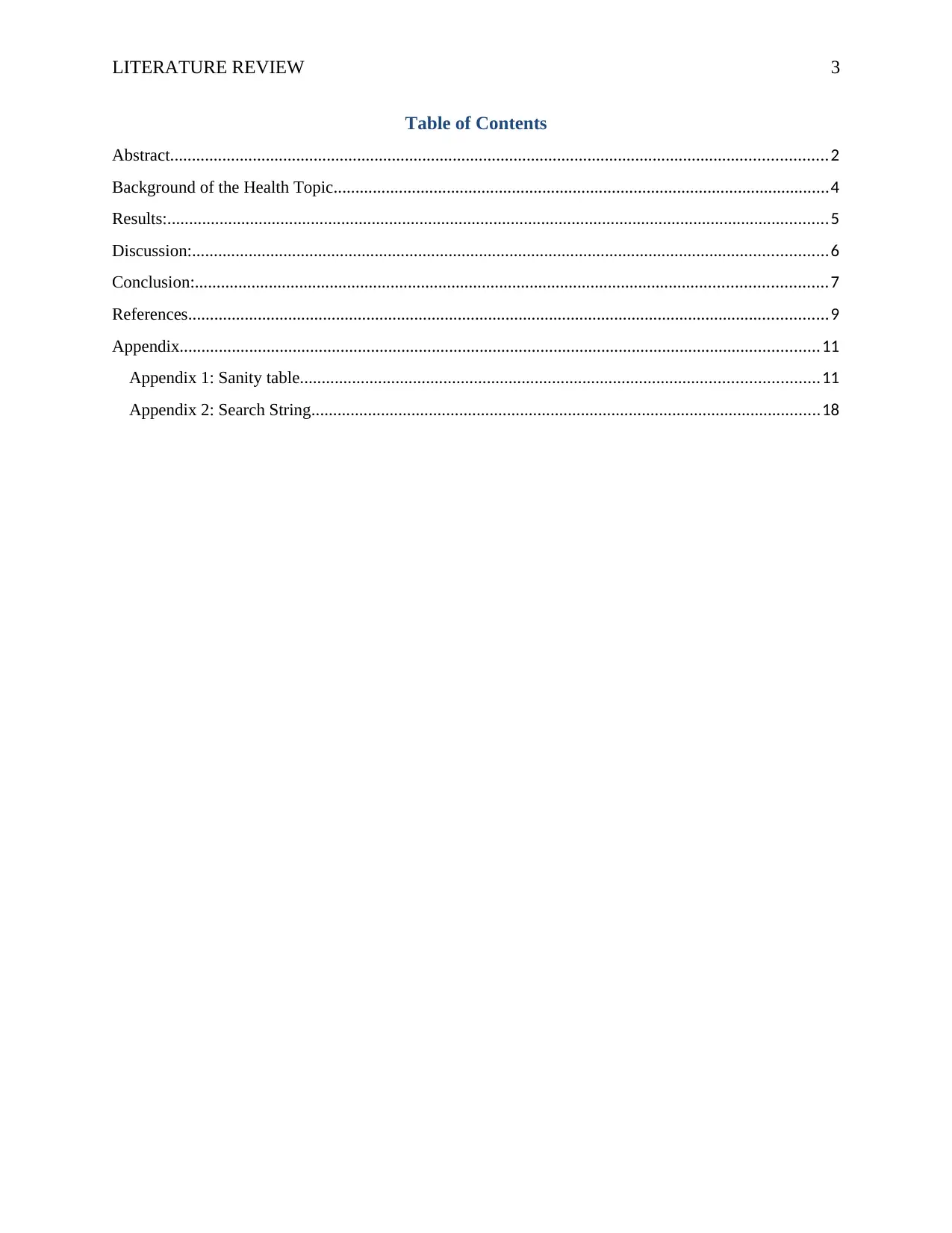
LITERATURE REVIEW 3
Table of Contents
Abstract.......................................................................................................................................................2
Background of the Health Topic..................................................................................................................4
Results:........................................................................................................................................................5
Discussion:..................................................................................................................................................6
Conclusion:.................................................................................................................................................7
References...................................................................................................................................................9
Appendix...................................................................................................................................................11
Appendix 1: Sanity table.......................................................................................................................11
Appendix 2: Search String.....................................................................................................................18
Table of Contents
Abstract.......................................................................................................................................................2
Background of the Health Topic..................................................................................................................4
Results:........................................................................................................................................................5
Discussion:..................................................................................................................................................6
Conclusion:.................................................................................................................................................7
References...................................................................................................................................................9
Appendix...................................................................................................................................................11
Appendix 1: Sanity table.......................................................................................................................11
Appendix 2: Search String.....................................................................................................................18
⊘ This is a preview!⊘
Do you want full access?
Subscribe today to unlock all pages.

Trusted by 1+ million students worldwide
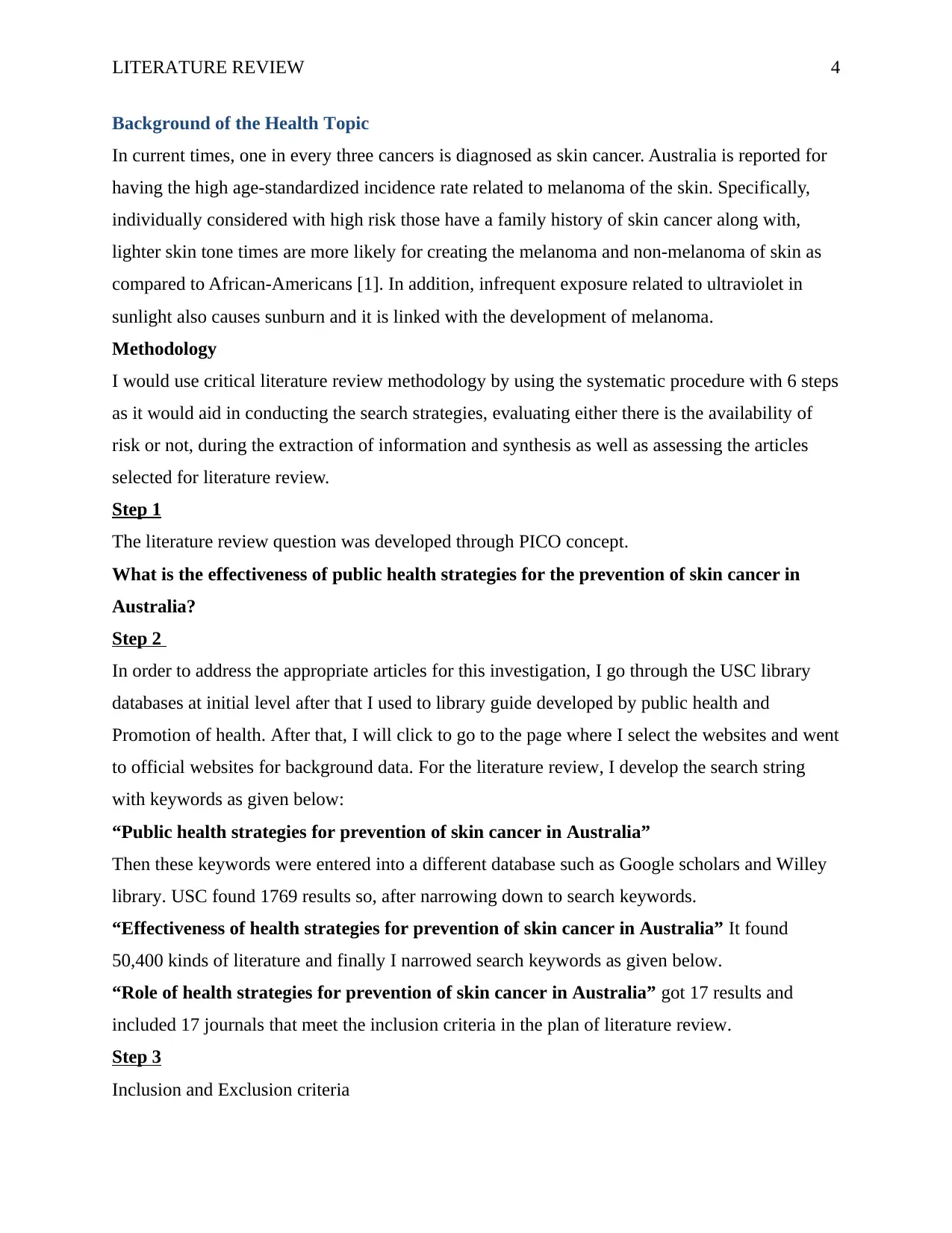
LITERATURE REVIEW 4
Background of the Health Topic
In current times, one in every three cancers is diagnosed as skin cancer. Australia is reported for
having the high age-standardized incidence rate related to melanoma of the skin. Specifically,
individually considered with high risk those have a family history of skin cancer along with,
lighter skin tone times are more likely for creating the melanoma and non-melanoma of skin as
compared to African-Americans [1]. In addition, infrequent exposure related to ultraviolet in
sunlight also causes sunburn and it is linked with the development of melanoma.
Methodology
I would use critical literature review methodology by using the systematic procedure with 6 steps
as it would aid in conducting the search strategies, evaluating either there is the availability of
risk or not, during the extraction of information and synthesis as well as assessing the articles
selected for literature review.
Step 1
The literature review question was developed through PICO concept.
What is the effectiveness of public health strategies for the prevention of skin cancer in
Australia?
Step 2
In order to address the appropriate articles for this investigation, I go through the USC library
databases at initial level after that I used to library guide developed by public health and
Promotion of health. After that, I will click to go to the page where I select the websites and went
to official websites for background data. For the literature review, I develop the search string
with keywords as given below:
“Public health strategies for prevention of skin cancer in Australia”
Then these keywords were entered into a different database such as Google scholars and Willey
library. USC found 1769 results so, after narrowing down to search keywords.
“Effectiveness of health strategies for prevention of skin cancer in Australia” It found
50,400 kinds of literature and finally I narrowed search keywords as given below.
“Role of health strategies for prevention of skin cancer in Australia” got 17 results and
included 17 journals that meet the inclusion criteria in the plan of literature review.
Step 3
Inclusion and Exclusion criteria
Background of the Health Topic
In current times, one in every three cancers is diagnosed as skin cancer. Australia is reported for
having the high age-standardized incidence rate related to melanoma of the skin. Specifically,
individually considered with high risk those have a family history of skin cancer along with,
lighter skin tone times are more likely for creating the melanoma and non-melanoma of skin as
compared to African-Americans [1]. In addition, infrequent exposure related to ultraviolet in
sunlight also causes sunburn and it is linked with the development of melanoma.
Methodology
I would use critical literature review methodology by using the systematic procedure with 6 steps
as it would aid in conducting the search strategies, evaluating either there is the availability of
risk or not, during the extraction of information and synthesis as well as assessing the articles
selected for literature review.
Step 1
The literature review question was developed through PICO concept.
What is the effectiveness of public health strategies for the prevention of skin cancer in
Australia?
Step 2
In order to address the appropriate articles for this investigation, I go through the USC library
databases at initial level after that I used to library guide developed by public health and
Promotion of health. After that, I will click to go to the page where I select the websites and went
to official websites for background data. For the literature review, I develop the search string
with keywords as given below:
“Public health strategies for prevention of skin cancer in Australia”
Then these keywords were entered into a different database such as Google scholars and Willey
library. USC found 1769 results so, after narrowing down to search keywords.
“Effectiveness of health strategies for prevention of skin cancer in Australia” It found
50,400 kinds of literature and finally I narrowed search keywords as given below.
“Role of health strategies for prevention of skin cancer in Australia” got 17 results and
included 17 journals that meet the inclusion criteria in the plan of literature review.
Step 3
Inclusion and Exclusion criteria
Paraphrase This Document
Need a fresh take? Get an instant paraphrase of this document with our AI Paraphraser
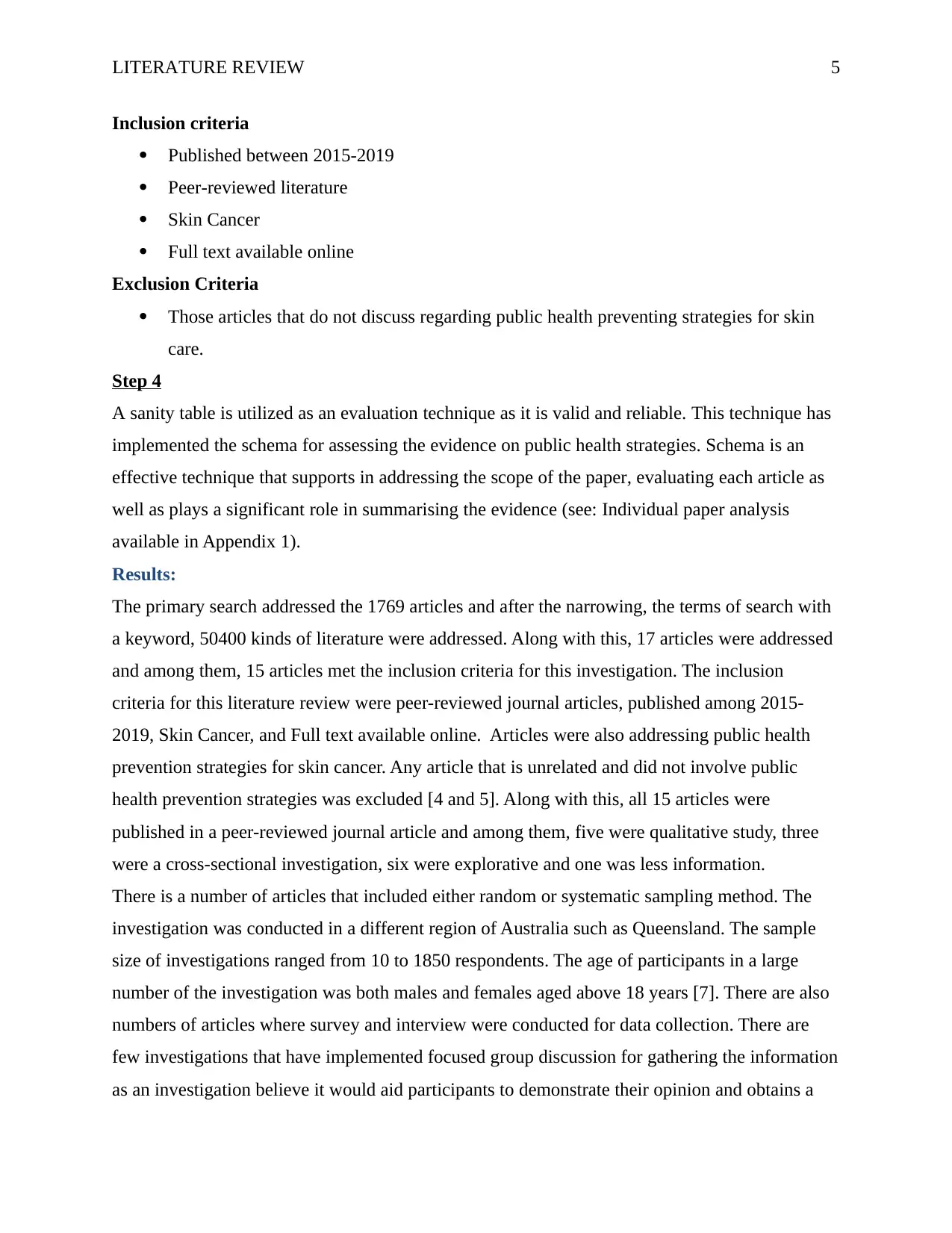
LITERATURE REVIEW 5
Inclusion criteria
Published between 2015-2019
Peer-reviewed literature
Skin Cancer
Full text available online
Exclusion Criteria
Those articles that do not discuss regarding public health preventing strategies for skin
care.
Step 4
A sanity table is utilized as an evaluation technique as it is valid and reliable. This technique has
implemented the schema for assessing the evidence on public health strategies. Schema is an
effective technique that supports in addressing the scope of the paper, evaluating each article as
well as plays a significant role in summarising the evidence (see: Individual paper analysis
available in Appendix 1).
Results:
The primary search addressed the 1769 articles and after the narrowing, the terms of search with
a keyword, 50400 kinds of literature were addressed. Along with this, 17 articles were addressed
and among them, 15 articles met the inclusion criteria for this investigation. The inclusion
criteria for this literature review were peer-reviewed journal articles, published among 2015-
2019, Skin Cancer, and Full text available online. Articles were also addressing public health
prevention strategies for skin cancer. Any article that is unrelated and did not involve public
health prevention strategies was excluded [4 and 5]. Along with this, all 15 articles were
published in a peer-reviewed journal article and among them, five were qualitative study, three
were a cross-sectional investigation, six were explorative and one was less information.
There is a number of articles that included either random or systematic sampling method. The
investigation was conducted in a different region of Australia such as Queensland. The sample
size of investigations ranged from 10 to 1850 respondents. The age of participants in a large
number of the investigation was both males and females aged above 18 years [7]. There are also
numbers of articles where survey and interview were conducted for data collection. There are
few investigations that have implemented focused group discussion for gathering the information
as an investigation believe it would aid participants to demonstrate their opinion and obtains a
Inclusion criteria
Published between 2015-2019
Peer-reviewed literature
Skin Cancer
Full text available online
Exclusion Criteria
Those articles that do not discuss regarding public health preventing strategies for skin
care.
Step 4
A sanity table is utilized as an evaluation technique as it is valid and reliable. This technique has
implemented the schema for assessing the evidence on public health strategies. Schema is an
effective technique that supports in addressing the scope of the paper, evaluating each article as
well as plays a significant role in summarising the evidence (see: Individual paper analysis
available in Appendix 1).
Results:
The primary search addressed the 1769 articles and after the narrowing, the terms of search with
a keyword, 50400 kinds of literature were addressed. Along with this, 17 articles were addressed
and among them, 15 articles met the inclusion criteria for this investigation. The inclusion
criteria for this literature review were peer-reviewed journal articles, published among 2015-
2019, Skin Cancer, and Full text available online. Articles were also addressing public health
prevention strategies for skin cancer. Any article that is unrelated and did not involve public
health prevention strategies was excluded [4 and 5]. Along with this, all 15 articles were
published in a peer-reviewed journal article and among them, five were qualitative study, three
were a cross-sectional investigation, six were explorative and one was less information.
There is a number of articles that included either random or systematic sampling method. The
investigation was conducted in a different region of Australia such as Queensland. The sample
size of investigations ranged from 10 to 1850 respondents. The age of participants in a large
number of the investigation was both males and females aged above 18 years [7]. There are also
numbers of articles where survey and interview were conducted for data collection. There are
few investigations that have implemented focused group discussion for gathering the information
as an investigation believe it would aid participants to demonstrate their opinion and obtains a
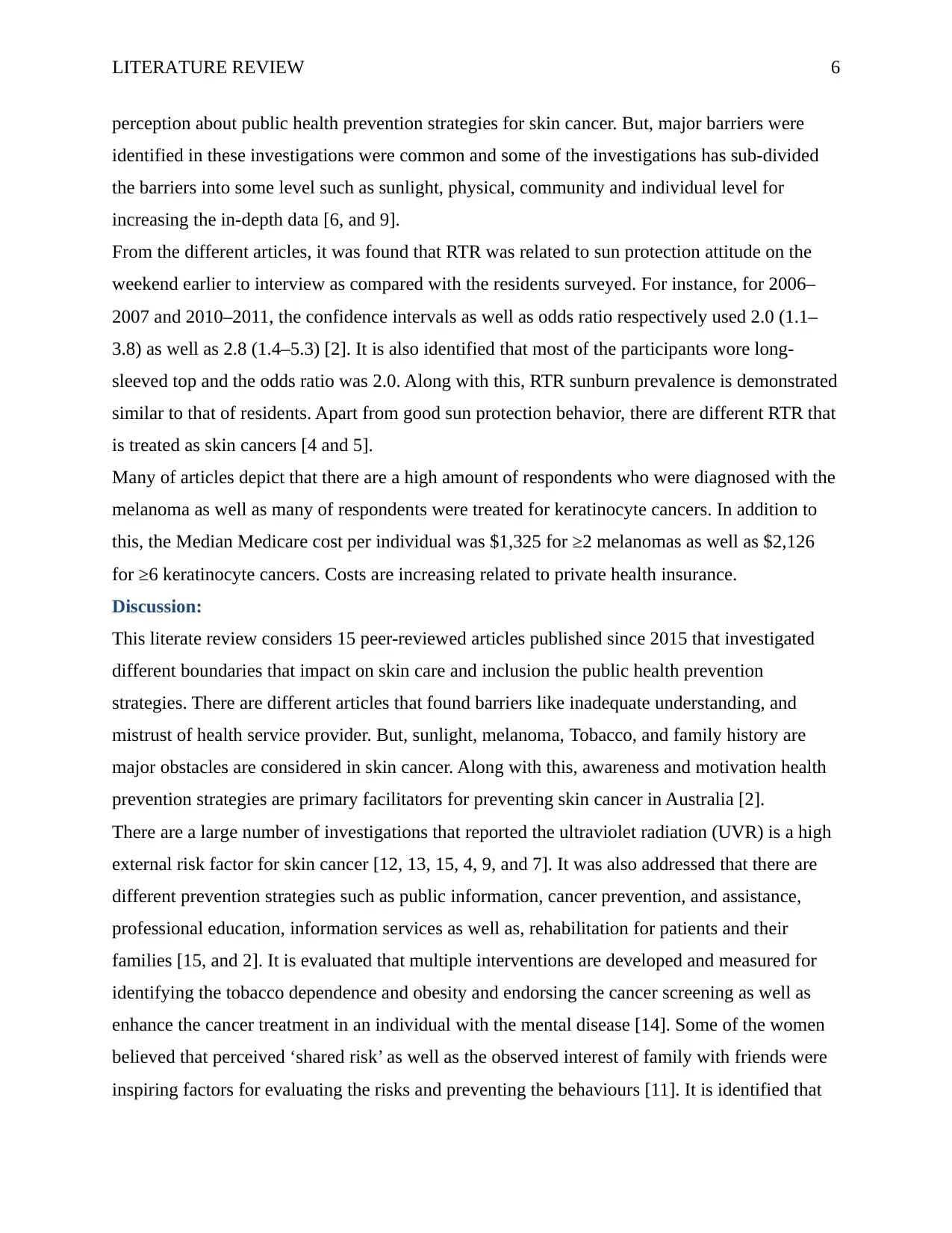
LITERATURE REVIEW 6
perception about public health prevention strategies for skin cancer. But, major barriers were
identified in these investigations were common and some of the investigations has sub-divided
the barriers into some level such as sunlight, physical, community and individual level for
increasing the in-depth data [6, and 9].
From the different articles, it was found that RTR was related to sun protection attitude on the
weekend earlier to interview as compared with the residents surveyed. For instance, for 2006–
2007 and 2010–2011, the confidence intervals as well as odds ratio respectively used 2.0 (1.1–
3.8) as well as 2.8 (1.4–5.3) [2]. It is also identified that most of the participants wore long-
sleeved top and the odds ratio was 2.0. Along with this, RTR sunburn prevalence is demonstrated
similar to that of residents. Apart from good sun protection behavior, there are different RTR that
is treated as skin cancers [4 and 5].
Many of articles depict that there are a high amount of respondents who were diagnosed with the
melanoma as well as many of respondents were treated for keratinocyte cancers. In addition to
this, the Median Medicare cost per individual was $1,325 for ≥2 melanomas as well as $2,126
for ≥6 keratinocyte cancers. Costs are increasing related to private health insurance.
Discussion:
This literate review considers 15 peer-reviewed articles published since 2015 that investigated
different boundaries that impact on skin care and inclusion the public health prevention
strategies. There are different articles that found barriers like inadequate understanding, and
mistrust of health service provider. But, sunlight, melanoma, Tobacco, and family history are
major obstacles are considered in skin cancer. Along with this, awareness and motivation health
prevention strategies are primary facilitators for preventing skin cancer in Australia [2].
There are a large number of investigations that reported the ultraviolet radiation (UVR) is a high
external risk factor for skin cancer [12, 13, 15, 4, 9, and 7]. It was also addressed that there are
different prevention strategies such as public information, cancer prevention, and assistance,
professional education, information services as well as, rehabilitation for patients and their
families [15, and 2]. It is evaluated that multiple interventions are developed and measured for
identifying the tobacco dependence and obesity and endorsing the cancer screening as well as
enhance the cancer treatment in an individual with the mental disease [14]. Some of the women
believed that perceived ‘shared risk’ as well as the observed interest of family with friends were
inspiring factors for evaluating the risks and preventing the behaviours [11]. It is identified that
perception about public health prevention strategies for skin cancer. But, major barriers were
identified in these investigations were common and some of the investigations has sub-divided
the barriers into some level such as sunlight, physical, community and individual level for
increasing the in-depth data [6, and 9].
From the different articles, it was found that RTR was related to sun protection attitude on the
weekend earlier to interview as compared with the residents surveyed. For instance, for 2006–
2007 and 2010–2011, the confidence intervals as well as odds ratio respectively used 2.0 (1.1–
3.8) as well as 2.8 (1.4–5.3) [2]. It is also identified that most of the participants wore long-
sleeved top and the odds ratio was 2.0. Along with this, RTR sunburn prevalence is demonstrated
similar to that of residents. Apart from good sun protection behavior, there are different RTR that
is treated as skin cancers [4 and 5].
Many of articles depict that there are a high amount of respondents who were diagnosed with the
melanoma as well as many of respondents were treated for keratinocyte cancers. In addition to
this, the Median Medicare cost per individual was $1,325 for ≥2 melanomas as well as $2,126
for ≥6 keratinocyte cancers. Costs are increasing related to private health insurance.
Discussion:
This literate review considers 15 peer-reviewed articles published since 2015 that investigated
different boundaries that impact on skin care and inclusion the public health prevention
strategies. There are different articles that found barriers like inadequate understanding, and
mistrust of health service provider. But, sunlight, melanoma, Tobacco, and family history are
major obstacles are considered in skin cancer. Along with this, awareness and motivation health
prevention strategies are primary facilitators for preventing skin cancer in Australia [2].
There are a large number of investigations that reported the ultraviolet radiation (UVR) is a high
external risk factor for skin cancer [12, 13, 15, 4, 9, and 7]. It was also addressed that there are
different prevention strategies such as public information, cancer prevention, and assistance,
professional education, information services as well as, rehabilitation for patients and their
families [15, and 2]. It is evaluated that multiple interventions are developed and measured for
identifying the tobacco dependence and obesity and endorsing the cancer screening as well as
enhance the cancer treatment in an individual with the mental disease [14]. Some of the women
believed that perceived ‘shared risk’ as well as the observed interest of family with friends were
inspiring factors for evaluating the risks and preventing the behaviours [11]. It is identified that
⊘ This is a preview!⊘
Do you want full access?
Subscribe today to unlock all pages.

Trusted by 1+ million students worldwide
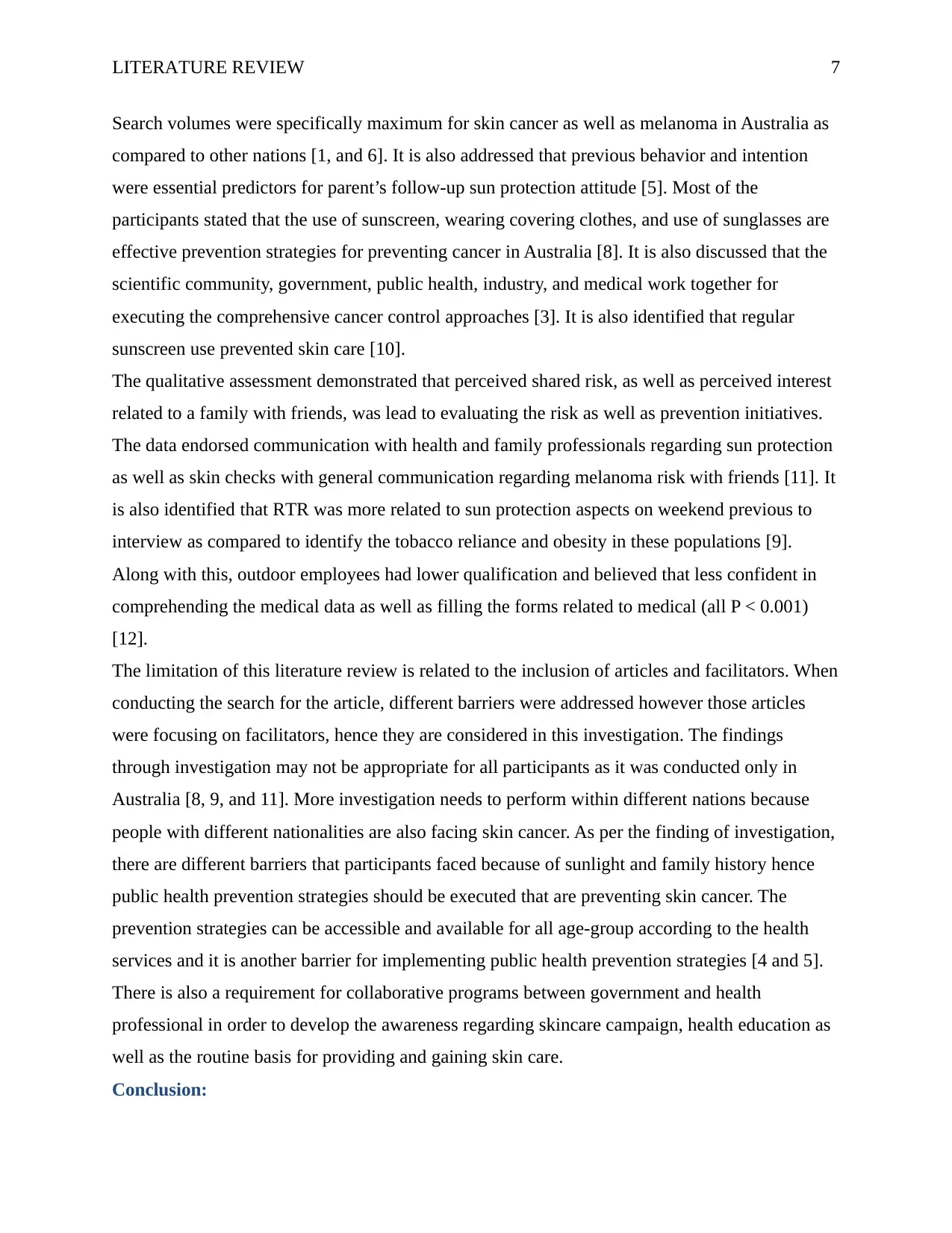
LITERATURE REVIEW 7
Search volumes were specifically maximum for skin cancer as well as melanoma in Australia as
compared to other nations [1, and 6]. It is also addressed that previous behavior and intention
were essential predictors for parent’s follow-up sun protection attitude [5]. Most of the
participants stated that the use of sunscreen, wearing covering clothes, and use of sunglasses are
effective prevention strategies for preventing cancer in Australia [8]. It is also discussed that the
scientific community, government, public health, industry, and medical work together for
executing the comprehensive cancer control approaches [3]. It is also identified that regular
sunscreen use prevented skin care [10].
The qualitative assessment demonstrated that perceived shared risk, as well as perceived interest
related to a family with friends, was lead to evaluating the risk as well as prevention initiatives.
The data endorsed communication with health and family professionals regarding sun protection
as well as skin checks with general communication regarding melanoma risk with friends [11]. It
is also identified that RTR was more related to sun protection aspects on weekend previous to
interview as compared to identify the tobacco reliance and obesity in these populations [9].
Along with this, outdoor employees had lower qualification and believed that less confident in
comprehending the medical data as well as filling the forms related to medical (all P < 0.001)
[12].
The limitation of this literature review is related to the inclusion of articles and facilitators. When
conducting the search for the article, different barriers were addressed however those articles
were focusing on facilitators, hence they are considered in this investigation. The findings
through investigation may not be appropriate for all participants as it was conducted only in
Australia [8, 9, and 11]. More investigation needs to perform within different nations because
people with different nationalities are also facing skin cancer. As per the finding of investigation,
there are different barriers that participants faced because of sunlight and family history hence
public health prevention strategies should be executed that are preventing skin cancer. The
prevention strategies can be accessible and available for all age-group according to the health
services and it is another barrier for implementing public health prevention strategies [4 and 5].
There is also a requirement for collaborative programs between government and health
professional in order to develop the awareness regarding skincare campaign, health education as
well as the routine basis for providing and gaining skin care.
Conclusion:
Search volumes were specifically maximum for skin cancer as well as melanoma in Australia as
compared to other nations [1, and 6]. It is also addressed that previous behavior and intention
were essential predictors for parent’s follow-up sun protection attitude [5]. Most of the
participants stated that the use of sunscreen, wearing covering clothes, and use of sunglasses are
effective prevention strategies for preventing cancer in Australia [8]. It is also discussed that the
scientific community, government, public health, industry, and medical work together for
executing the comprehensive cancer control approaches [3]. It is also identified that regular
sunscreen use prevented skin care [10].
The qualitative assessment demonstrated that perceived shared risk, as well as perceived interest
related to a family with friends, was lead to evaluating the risk as well as prevention initiatives.
The data endorsed communication with health and family professionals regarding sun protection
as well as skin checks with general communication regarding melanoma risk with friends [11]. It
is also identified that RTR was more related to sun protection aspects on weekend previous to
interview as compared to identify the tobacco reliance and obesity in these populations [9].
Along with this, outdoor employees had lower qualification and believed that less confident in
comprehending the medical data as well as filling the forms related to medical (all P < 0.001)
[12].
The limitation of this literature review is related to the inclusion of articles and facilitators. When
conducting the search for the article, different barriers were addressed however those articles
were focusing on facilitators, hence they are considered in this investigation. The findings
through investigation may not be appropriate for all participants as it was conducted only in
Australia [8, 9, and 11]. More investigation needs to perform within different nations because
people with different nationalities are also facing skin cancer. As per the finding of investigation,
there are different barriers that participants faced because of sunlight and family history hence
public health prevention strategies should be executed that are preventing skin cancer. The
prevention strategies can be accessible and available for all age-group according to the health
services and it is another barrier for implementing public health prevention strategies [4 and 5].
There is also a requirement for collaborative programs between government and health
professional in order to develop the awareness regarding skincare campaign, health education as
well as the routine basis for providing and gaining skin care.
Conclusion:
Paraphrase This Document
Need a fresh take? Get an instant paraphrase of this document with our AI Paraphraser
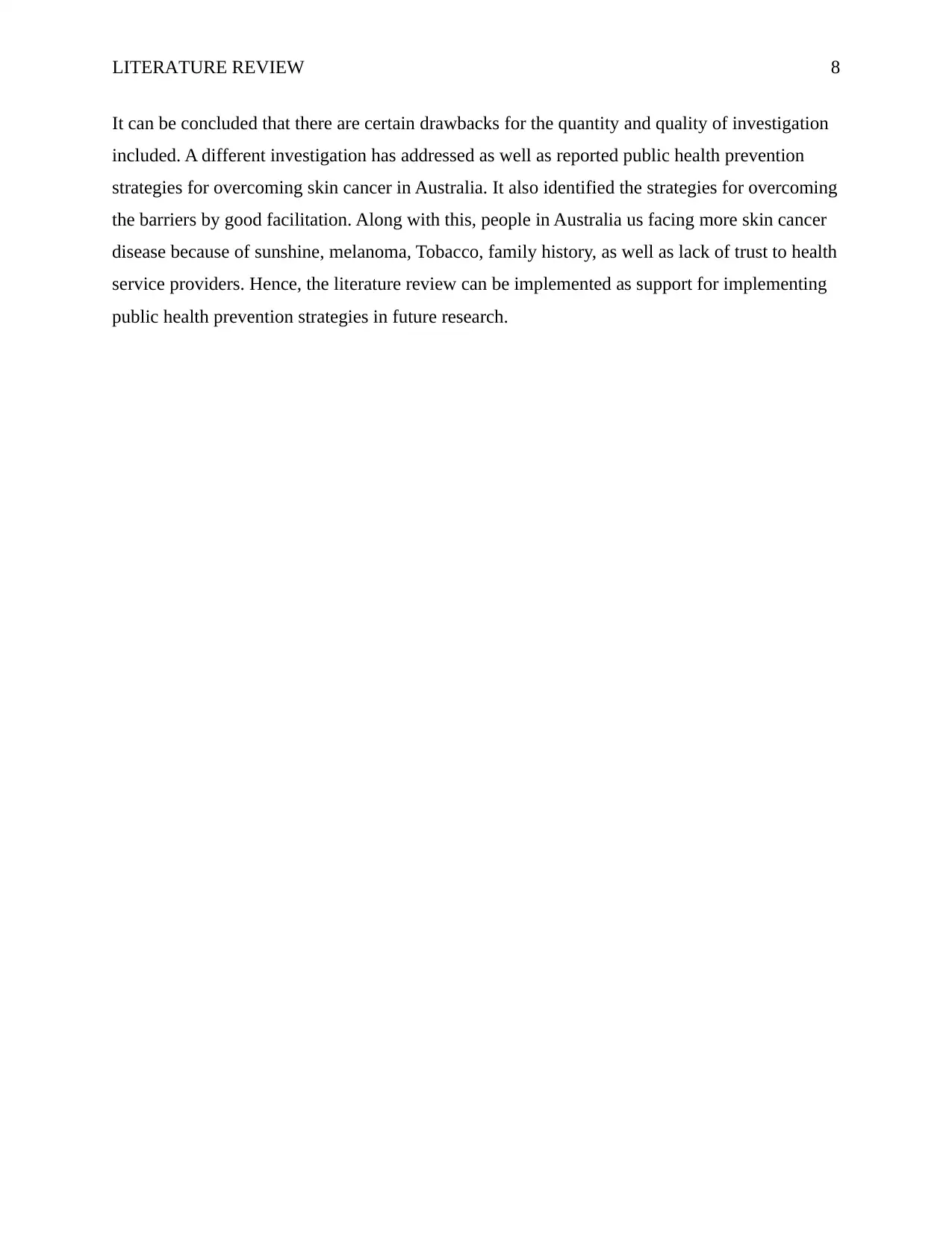
LITERATURE REVIEW 8
It can be concluded that there are certain drawbacks for the quantity and quality of investigation
included. A different investigation has addressed as well as reported public health prevention
strategies for overcoming skin cancer in Australia. It also identified the strategies for overcoming
the barriers by good facilitation. Along with this, people in Australia us facing more skin cancer
disease because of sunshine, melanoma, Tobacco, family history, as well as lack of trust to health
service providers. Hence, the literature review can be implemented as support for implementing
public health prevention strategies in future research.
It can be concluded that there are certain drawbacks for the quantity and quality of investigation
included. A different investigation has addressed as well as reported public health prevention
strategies for overcoming skin cancer in Australia. It also identified the strategies for overcoming
the barriers by good facilitation. Along with this, people in Australia us facing more skin cancer
disease because of sunshine, melanoma, Tobacco, family history, as well as lack of trust to health
service providers. Hence, the literature review can be implemented as support for implementing
public health prevention strategies in future research.
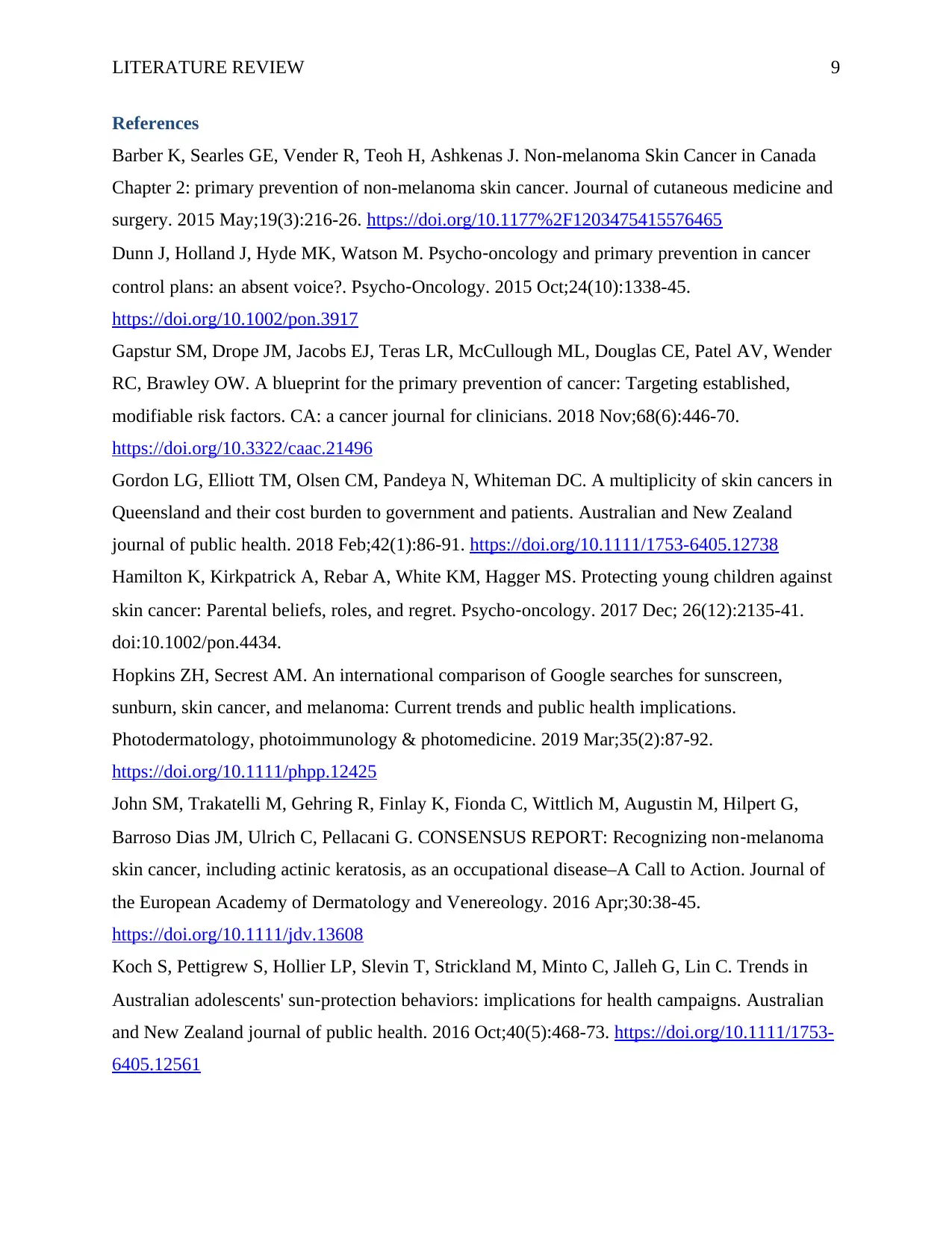
LITERATURE REVIEW 9
References
Barber K, Searles GE, Vender R, Teoh H, Ashkenas J. Non-melanoma Skin Cancer in Canada
Chapter 2: primary prevention of non-melanoma skin cancer. Journal of cutaneous medicine and
surgery. 2015 May;19(3):216-26. https://doi.org/10.1177%2F1203475415576465
Dunn J, Holland J, Hyde MK, Watson M. Psycho‐oncology and primary prevention in cancer
control plans: an absent voice?. Psycho‐Oncology. 2015 Oct;24(10):1338-45.
https://doi.org/10.1002/pon.3917
Gapstur SM, Drope JM, Jacobs EJ, Teras LR, McCullough ML, Douglas CE, Patel AV, Wender
RC, Brawley OW. A blueprint for the primary prevention of cancer: Targeting established,
modifiable risk factors. CA: a cancer journal for clinicians. 2018 Nov;68(6):446-70.
https://doi.org/10.3322/caac.21496
Gordon LG, Elliott TM, Olsen CM, Pandeya N, Whiteman DC. A multiplicity of skin cancers in
Queensland and their cost burden to government and patients. Australian and New Zealand
journal of public health. 2018 Feb;42(1):86-91. https://doi.org/10.1111/1753-6405.12738
Hamilton K, Kirkpatrick A, Rebar A, White KM, Hagger MS. Protecting young children against
skin cancer: Parental beliefs, roles, and regret. Psycho‐oncology. 2017 Dec; 26(12):2135-41.
doi:10.1002/pon.4434.
Hopkins ZH, Secrest AM. An international comparison of Google searches for sunscreen,
sunburn, skin cancer, and melanoma: Current trends and public health implications.
Photodermatology, photoimmunology & photomedicine. 2019 Mar;35(2):87-92.
https://doi.org/10.1111/phpp.12425
John SM, Trakatelli M, Gehring R, Finlay K, Fionda C, Wittlich M, Augustin M, Hilpert G,
Barroso Dias JM, Ulrich C, Pellacani G. CONSENSUS REPORT: Recognizing non‐melanoma
skin cancer, including actinic keratosis, as an occupational disease–A Call to Action. Journal of
the European Academy of Dermatology and Venereology. 2016 Apr;30:38-45.
https://doi.org/10.1111/jdv.13608
Koch S, Pettigrew S, Hollier LP, Slevin T, Strickland M, Minto C, Jalleh G, Lin C. Trends in
Australian adolescents' sun‐protection behaviors: implications for health campaigns. Australian
and New Zealand journal of public health. 2016 Oct;40(5):468-73. https://doi.org/10.1111/1753-
6405.12561
References
Barber K, Searles GE, Vender R, Teoh H, Ashkenas J. Non-melanoma Skin Cancer in Canada
Chapter 2: primary prevention of non-melanoma skin cancer. Journal of cutaneous medicine and
surgery. 2015 May;19(3):216-26. https://doi.org/10.1177%2F1203475415576465
Dunn J, Holland J, Hyde MK, Watson M. Psycho‐oncology and primary prevention in cancer
control plans: an absent voice?. Psycho‐Oncology. 2015 Oct;24(10):1338-45.
https://doi.org/10.1002/pon.3917
Gapstur SM, Drope JM, Jacobs EJ, Teras LR, McCullough ML, Douglas CE, Patel AV, Wender
RC, Brawley OW. A blueprint for the primary prevention of cancer: Targeting established,
modifiable risk factors. CA: a cancer journal for clinicians. 2018 Nov;68(6):446-70.
https://doi.org/10.3322/caac.21496
Gordon LG, Elliott TM, Olsen CM, Pandeya N, Whiteman DC. A multiplicity of skin cancers in
Queensland and their cost burden to government and patients. Australian and New Zealand
journal of public health. 2018 Feb;42(1):86-91. https://doi.org/10.1111/1753-6405.12738
Hamilton K, Kirkpatrick A, Rebar A, White KM, Hagger MS. Protecting young children against
skin cancer: Parental beliefs, roles, and regret. Psycho‐oncology. 2017 Dec; 26(12):2135-41.
doi:10.1002/pon.4434.
Hopkins ZH, Secrest AM. An international comparison of Google searches for sunscreen,
sunburn, skin cancer, and melanoma: Current trends and public health implications.
Photodermatology, photoimmunology & photomedicine. 2019 Mar;35(2):87-92.
https://doi.org/10.1111/phpp.12425
John SM, Trakatelli M, Gehring R, Finlay K, Fionda C, Wittlich M, Augustin M, Hilpert G,
Barroso Dias JM, Ulrich C, Pellacani G. CONSENSUS REPORT: Recognizing non‐melanoma
skin cancer, including actinic keratosis, as an occupational disease–A Call to Action. Journal of
the European Academy of Dermatology and Venereology. 2016 Apr;30:38-45.
https://doi.org/10.1111/jdv.13608
Koch S, Pettigrew S, Hollier LP, Slevin T, Strickland M, Minto C, Jalleh G, Lin C. Trends in
Australian adolescents' sun‐protection behaviors: implications for health campaigns. Australian
and New Zealand journal of public health. 2016 Oct;40(5):468-73. https://doi.org/10.1111/1753-
6405.12561
⊘ This is a preview!⊘
Do you want full access?
Subscribe today to unlock all pages.

Trusted by 1+ million students worldwide
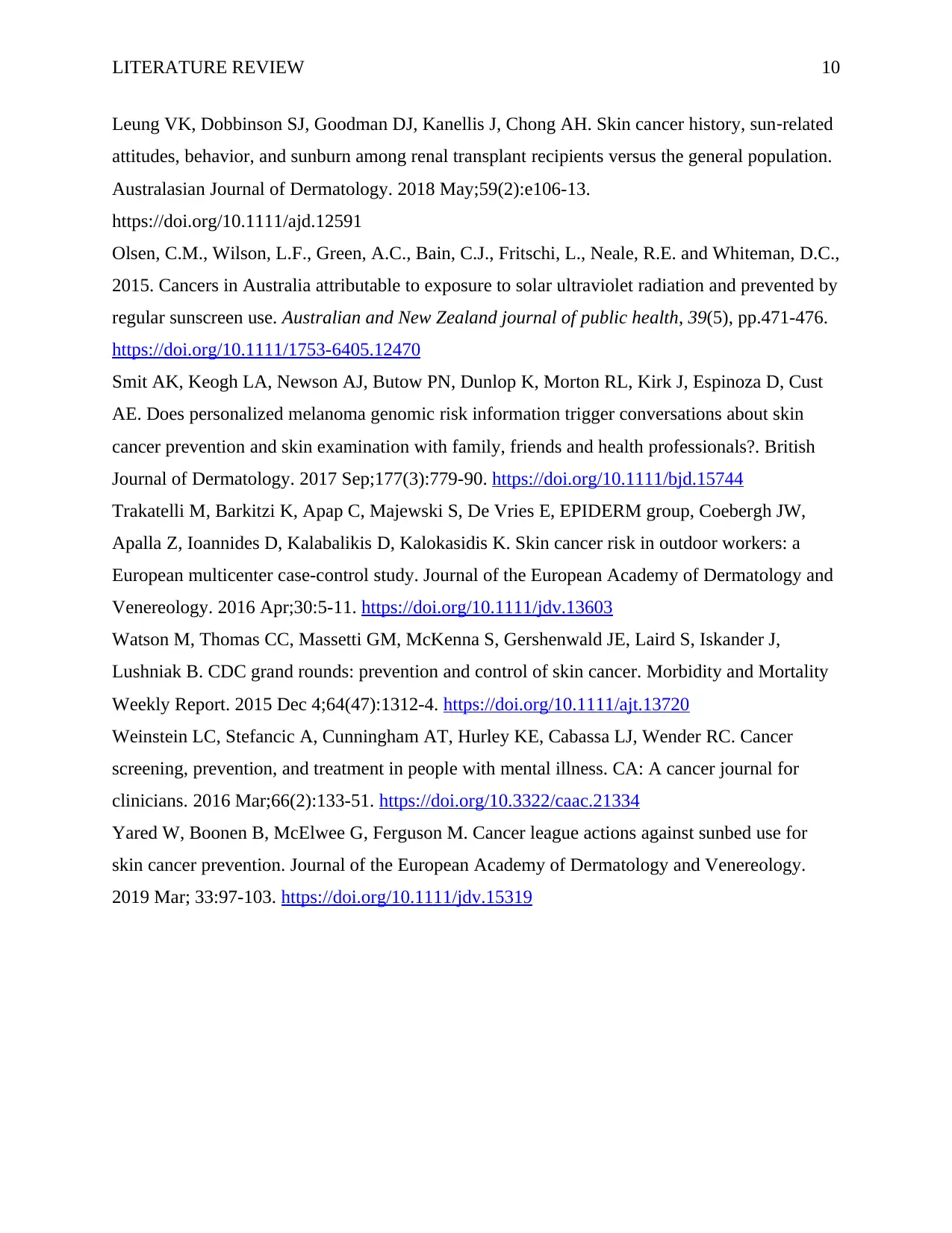
LITERATURE REVIEW 10
Leung VK, Dobbinson SJ, Goodman DJ, Kanellis J, Chong AH. Skin cancer history, sun‐related
attitudes, behavior, and sunburn among renal transplant recipients versus the general population.
Australasian Journal of Dermatology. 2018 May;59(2):e106-13.
https://doi.org/10.1111/ajd.12591
Olsen, C.M., Wilson, L.F., Green, A.C., Bain, C.J., Fritschi, L., Neale, R.E. and Whiteman, D.C.,
2015. Cancers in Australia attributable to exposure to solar ultraviolet radiation and prevented by
regular sunscreen use. Australian and New Zealand journal of public health, 39(5), pp.471-476.
https://doi.org/10.1111/1753-6405.12470
Smit AK, Keogh LA, Newson AJ, Butow PN, Dunlop K, Morton RL, Kirk J, Espinoza D, Cust
AE. Does personalized melanoma genomic risk information trigger conversations about skin
cancer prevention and skin examination with family, friends and health professionals?. British
Journal of Dermatology. 2017 Sep;177(3):779-90. https://doi.org/10.1111/bjd.15744
Trakatelli M, Barkitzi K, Apap C, Majewski S, De Vries E, EPIDERM group, Coebergh JW,
Apalla Z, Ioannides D, Kalabalikis D, Kalokasidis K. Skin cancer risk in outdoor workers: a
European multicenter case-control study. Journal of the European Academy of Dermatology and
Venereology. 2016 Apr;30:5-11. https://doi.org/10.1111/jdv.13603
Watson M, Thomas CC, Massetti GM, McKenna S, Gershenwald JE, Laird S, Iskander J,
Lushniak B. CDC grand rounds: prevention and control of skin cancer. Morbidity and Mortality
Weekly Report. 2015 Dec 4;64(47):1312-4. https://doi.org/10.1111/ajt.13720
Weinstein LC, Stefancic A, Cunningham AT, Hurley KE, Cabassa LJ, Wender RC. Cancer
screening, prevention, and treatment in people with mental illness. CA: A cancer journal for
clinicians. 2016 Mar;66(2):133-51. https://doi.org/10.3322/caac.21334
Yared W, Boonen B, McElwee G, Ferguson M. Cancer league actions against sunbed use for
skin cancer prevention. Journal of the European Academy of Dermatology and Venereology.
2019 Mar; 33:97-103. https://doi.org/10.1111/jdv.15319
Leung VK, Dobbinson SJ, Goodman DJ, Kanellis J, Chong AH. Skin cancer history, sun‐related
attitudes, behavior, and sunburn among renal transplant recipients versus the general population.
Australasian Journal of Dermatology. 2018 May;59(2):e106-13.
https://doi.org/10.1111/ajd.12591
Olsen, C.M., Wilson, L.F., Green, A.C., Bain, C.J., Fritschi, L., Neale, R.E. and Whiteman, D.C.,
2015. Cancers in Australia attributable to exposure to solar ultraviolet radiation and prevented by
regular sunscreen use. Australian and New Zealand journal of public health, 39(5), pp.471-476.
https://doi.org/10.1111/1753-6405.12470
Smit AK, Keogh LA, Newson AJ, Butow PN, Dunlop K, Morton RL, Kirk J, Espinoza D, Cust
AE. Does personalized melanoma genomic risk information trigger conversations about skin
cancer prevention and skin examination with family, friends and health professionals?. British
Journal of Dermatology. 2017 Sep;177(3):779-90. https://doi.org/10.1111/bjd.15744
Trakatelli M, Barkitzi K, Apap C, Majewski S, De Vries E, EPIDERM group, Coebergh JW,
Apalla Z, Ioannides D, Kalabalikis D, Kalokasidis K. Skin cancer risk in outdoor workers: a
European multicenter case-control study. Journal of the European Academy of Dermatology and
Venereology. 2016 Apr;30:5-11. https://doi.org/10.1111/jdv.13603
Watson M, Thomas CC, Massetti GM, McKenna S, Gershenwald JE, Laird S, Iskander J,
Lushniak B. CDC grand rounds: prevention and control of skin cancer. Morbidity and Mortality
Weekly Report. 2015 Dec 4;64(47):1312-4. https://doi.org/10.1111/ajt.13720
Weinstein LC, Stefancic A, Cunningham AT, Hurley KE, Cabassa LJ, Wender RC. Cancer
screening, prevention, and treatment in people with mental illness. CA: A cancer journal for
clinicians. 2016 Mar;66(2):133-51. https://doi.org/10.3322/caac.21334
Yared W, Boonen B, McElwee G, Ferguson M. Cancer league actions against sunbed use for
skin cancer prevention. Journal of the European Academy of Dermatology and Venereology.
2019 Mar; 33:97-103. https://doi.org/10.1111/jdv.15319
Paraphrase This Document
Need a fresh take? Get an instant paraphrase of this document with our AI Paraphraser
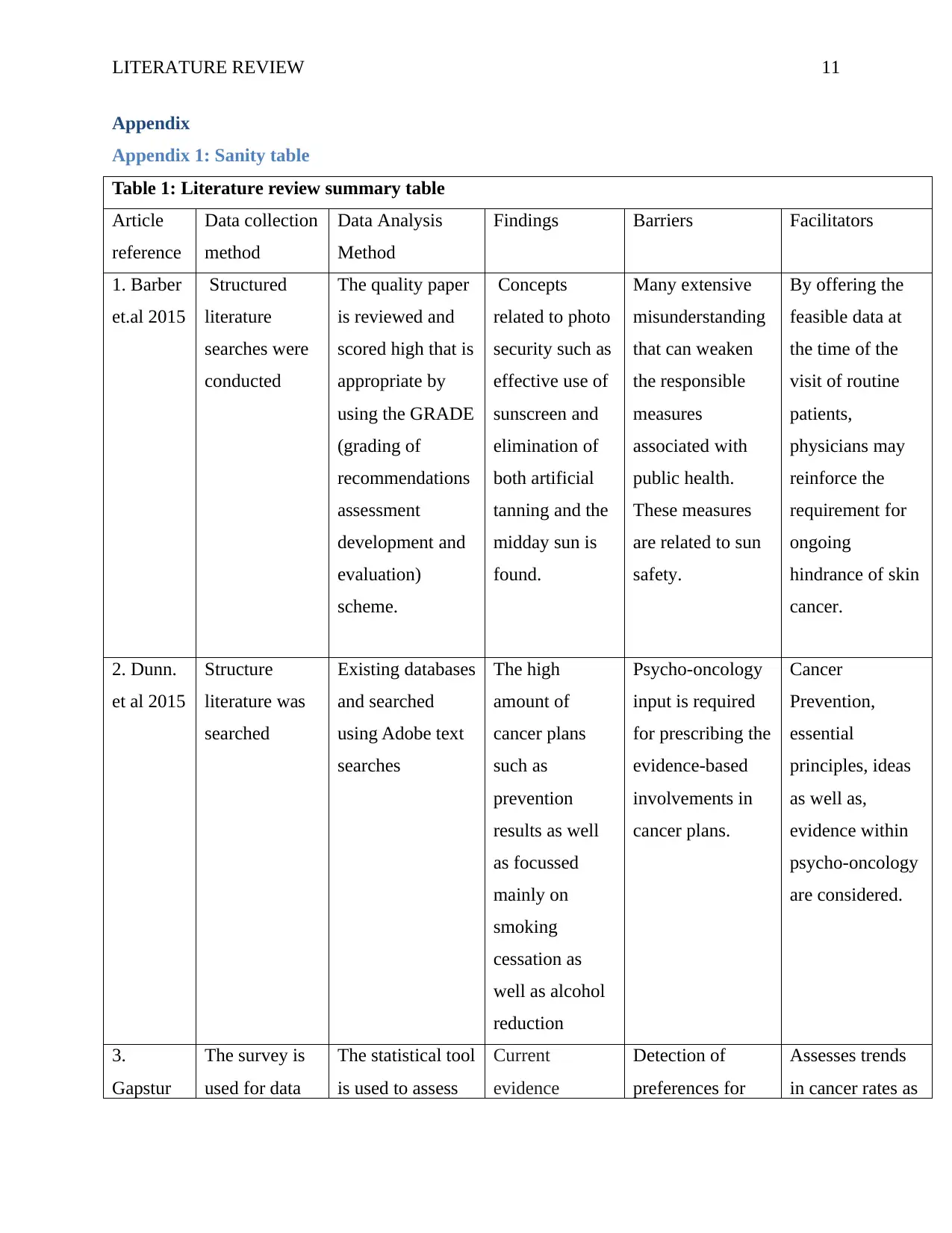
LITERATURE REVIEW 11
Appendix
Appendix 1: Sanity table
Table 1: Literature review summary table
Article
reference
Data collection
method
Data Analysis
Method
Findings Barriers Facilitators
1. Barber
et.al 2015
Structured
literature
searches were
conducted
The quality paper
is reviewed and
scored high that is
appropriate by
using the GRADE
(grading of
recommendations
assessment
development and
evaluation)
scheme.
Concepts
related to photo
security such as
effective use of
sunscreen and
elimination of
both artificial
tanning and the
midday sun is
found.
Many extensive
misunderstanding
that can weaken
the responsible
measures
associated with
public health.
These measures
are related to sun
safety.
By offering the
feasible data at
the time of the
visit of routine
patients,
physicians may
reinforce the
requirement for
ongoing
hindrance of skin
cancer.
2. Dunn.
et al 2015
Structure
literature was
searched
Existing databases
and searched
using Adobe text
searches
The high
amount of
cancer plans
such as
prevention
results as well
as focussed
mainly on
smoking
cessation as
well as alcohol
reduction
Psycho-oncology
input is required
for prescribing the
evidence-based
involvements in
cancer plans.
Cancer
Prevention,
essential
principles, ideas
as well as,
evidence within
psycho-oncology
are considered.
3.
Gapstur
The survey is
used for data
The statistical tool
is used to assess
Current
evidence
Detection of
preferences for
Assesses trends
in cancer rates as
Appendix
Appendix 1: Sanity table
Table 1: Literature review summary table
Article
reference
Data collection
method
Data Analysis
Method
Findings Barriers Facilitators
1. Barber
et.al 2015
Structured
literature
searches were
conducted
The quality paper
is reviewed and
scored high that is
appropriate by
using the GRADE
(grading of
recommendations
assessment
development and
evaluation)
scheme.
Concepts
related to photo
security such as
effective use of
sunscreen and
elimination of
both artificial
tanning and the
midday sun is
found.
Many extensive
misunderstanding
that can weaken
the responsible
measures
associated with
public health.
These measures
are related to sun
safety.
By offering the
feasible data at
the time of the
visit of routine
patients,
physicians may
reinforce the
requirement for
ongoing
hindrance of skin
cancer.
2. Dunn.
et al 2015
Structure
literature was
searched
Existing databases
and searched
using Adobe text
searches
The high
amount of
cancer plans
such as
prevention
results as well
as focussed
mainly on
smoking
cessation as
well as alcohol
reduction
Psycho-oncology
input is required
for prescribing the
evidence-based
involvements in
cancer plans.
Cancer
Prevention,
essential
principles, ideas
as well as,
evidence within
psycho-oncology
are considered.
3.
Gapstur
The survey is
used for data
The statistical tool
is used to assess
Current
evidence
Detection of
preferences for
Assesses trends
in cancer rates as
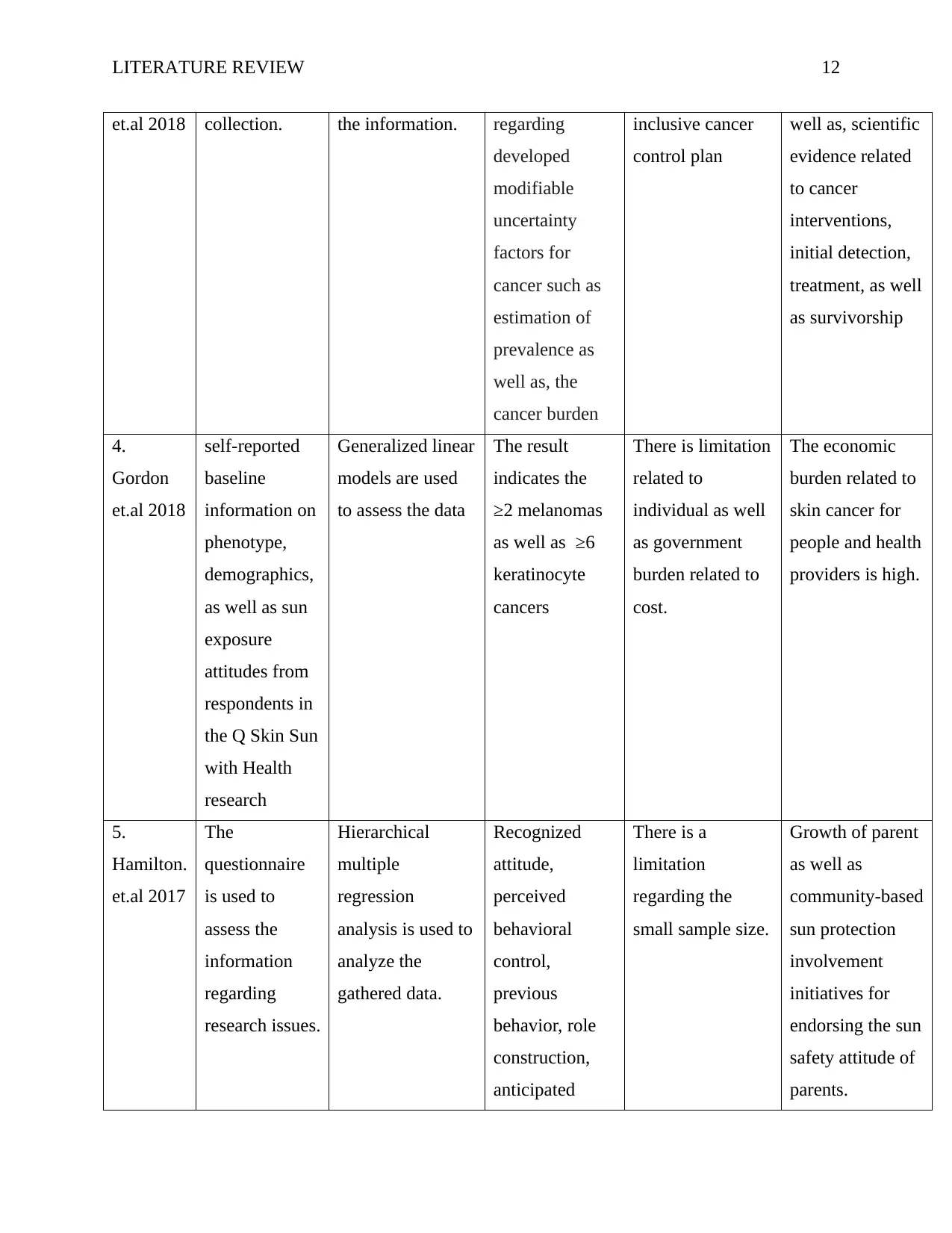
LITERATURE REVIEW 12
et.al 2018 collection. the information. regarding
developed
modifiable
uncertainty
factors for
cancer such as
estimation of
prevalence as
well as, the
cancer burden
inclusive cancer
control plan
well as, scientific
evidence related
to cancer
interventions,
initial detection,
treatment, as well
as survivorship
4.
Gordon
et.al 2018
self-reported
baseline
information on
phenotype,
demographics,
as well as sun
exposure
attitudes from
respondents in
the Q Skin Sun
with Health
research
Generalized linear
models are used
to assess the data
The result
indicates the
≥2 melanomas
as well as ≥6
keratinocyte
cancers
There is limitation
related to
individual as well
as government
burden related to
cost.
The economic
burden related to
skin cancer for
people and health
providers is high.
5.
Hamilton.
et.al 2017
The
questionnaire
is used to
assess the
information
regarding
research issues.
Hierarchical
multiple
regression
analysis is used to
analyze the
gathered data.
Recognized
attitude,
perceived
behavioral
control,
previous
behavior, role
construction,
anticipated
There is a
limitation
regarding the
small sample size.
Growth of parent
as well as
community-based
sun protection
involvement
initiatives for
endorsing the sun
safety attitude of
parents.
et.al 2018 collection. the information. regarding
developed
modifiable
uncertainty
factors for
cancer such as
estimation of
prevalence as
well as, the
cancer burden
inclusive cancer
control plan
well as, scientific
evidence related
to cancer
interventions,
initial detection,
treatment, as well
as survivorship
4.
Gordon
et.al 2018
self-reported
baseline
information on
phenotype,
demographics,
as well as sun
exposure
attitudes from
respondents in
the Q Skin Sun
with Health
research
Generalized linear
models are used
to assess the data
The result
indicates the
≥2 melanomas
as well as ≥6
keratinocyte
cancers
There is limitation
related to
individual as well
as government
burden related to
cost.
The economic
burden related to
skin cancer for
people and health
providers is high.
5.
Hamilton.
et.al 2017
The
questionnaire
is used to
assess the
information
regarding
research issues.
Hierarchical
multiple
regression
analysis is used to
analyze the
gathered data.
Recognized
attitude,
perceived
behavioral
control,
previous
behavior, role
construction,
anticipated
There is a
limitation
regarding the
small sample size.
Growth of parent
as well as
community-based
sun protection
involvement
initiatives for
endorsing the sun
safety attitude of
parents.
⊘ This is a preview!⊘
Do you want full access?
Subscribe today to unlock all pages.

Trusted by 1+ million students worldwide
1 out of 18
Related Documents
Your All-in-One AI-Powered Toolkit for Academic Success.
+13062052269
info@desklib.com
Available 24*7 on WhatsApp / Email
![[object Object]](/_next/static/media/star-bottom.7253800d.svg)
Unlock your academic potential
Copyright © 2020–2025 A2Z Services. All Rights Reserved. Developed and managed by ZUCOL.





